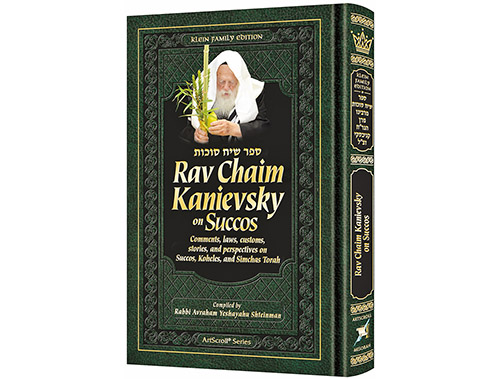
Highlighting: “Rav Chaim Kanievsky on Succos: Comments, laws, customs, stories, and perspectives on Succos, Koheles and Simchas Torah,” by Rabbi Avraham Yeshayahu Shteinman. ArtScroll/Mesorah Publications. 2022. Hardcover. 267 pages. ISBN-13: 978-1422632376.
(Courtesy of Artscroll) In the Kanievsky home, preparations for Sukkos started literally right after Pesach, as Rebbetzin Batsheva Kanievsky put the leftover matzah on the side, to be ground into flour that would be used when she baked challah for Sukkos. An esrog was chosen two months before the holiday, and Rav Chaim Kanievsky himself would go to pick the sechach. Then, as the Yom Tov started, the lofty levels of rejoicing and dveykus began.
We can no longer see Rav Chaim’s radiant face as he sat, surrounded by his sukkah walls, but we can feel the happiness and the kedushah through his writings about the Yom Tov, and, of course, through stories that capture his total immersion in the mitzvos of Sukkos. Rav Chaim Kanievsky on Sukkos is a brand new volume written by Rav Avraham Yeshaya Shteinman, grandson of both Rav Chaim and Rav Aharon Leib Shteinman. It includes:
- Rav Chaim’s halachic rulings and his customs on Sukkos, the arba minim, Chol Hamoed, Hoshanah Rabbah, Shemini Atzeres, Simchas Torah and sefer Koheles.
- Insights on many aspects of the Yom Tov, including the Sukkos tefillos, the “mitzvah” of joy, and dozens of other topics related to the holiday, perfect to be shared with family and friends in your sukkah.
- Warm and personal stories of the Chazon Ish, the Steipler Gaon, Rav Chaim and the Rebbetzin, Rav Shach, Rav Elyashiv, Rav Michel Yehudah Lefkowitz and other luminaries.
Rav Chaim Kanievsky on Sukkos will enhance your Yom Tov — and increase your joy in this “time of our rejoicing.”
The following is a brief excerpt from the new book, a fascinating segment about the bracha of “leisheiv basukkah.”
- • • • •
Leisheiv Basukkah
- The Vilna Gaon’s custom: Rav Chaim Kanievsky followed the custom of the Vilna Gaon to recite “leisheiv basukkah” even when merely sitting in the sukkah without eating, but as an added precaution, it is proper to eat something — so that the bracha can be recited according to all opinions.
- Leaving to daven: Rav Chaim said that when he leaves the sukkah to daven Minchah or Maariv, he does not recite a new bracha upon returning to the sukkah, since those are brief prayers, and he does not go far from the house. Shacharis, however, is a lengthy prayer, so after returning from Shacharis, he does recite a new bracha. He added that the Chazon Ish, too, did not recite a new bracha after leaving the sukkah to daven, except when it was for an extended period. Rav Chaim followed the same practice. However, Rav Chaim davened in the Lederman shul near his house, whereas the Chazon Ish davened with a minyan inside his house.
- Mezonos second: Rav Chaim said that if one eats Mezonos in the sukkah, and does not follow the custom of the Vilna Gaon to recite the blessing of “leisheiv basukkah” merely over sitting in the sukkah, he should recite the bracha of “leisheiv basukkah” first, and the bracha of “borei minei Mezonos” second.
Rav Eliyahu Mann related that he once recited the bracha of “borei minei Mezonos” in Rav Chaim’s sukkah and only then recited “leisheiv basukkah,” prompting Rav Chaim to note that his own custom was to say “leisheiv basukkah” before “borei minei Mezonos,” since some hold that one does not recite “leisheiv basukkah” over Mezonos, and reciting it after the bracha would, therefore, be considered an interruption (Mishnah Berurah 639:16).
- The Havdala quandary: Rav Chaim said that one who enters the sukkah only to recite Havdala faces a halachic quandary of whether to recite “leisheiv basukkah,” and it is, therefore, proper to eat something afterward, in which case he may recite “leisheiv basukkah” when he makes Havdala.









